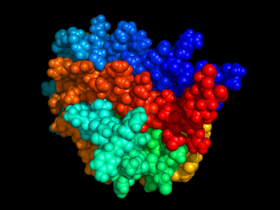| Erythropoiesis-stimulating agent | |
|---|---|
| Drug class | |
 Structure of erythropoietin | |
| Class identifiers | |
| Synonyms | Erythropoiesis-stimulating drugs,[3] erythropoietin-type blood factors[2] |
| Use | Anemia due to end stage kidney disease, chemotherapy, major surgery, or certain treatments in HIV/AIDS[1][2] |
| ATC code | B03XA |
| Legal status | |
| In Wikidata | |
Erythropoiesis-stimulating agents (ESA) are medications which stimulate the bone marrow to make red blood cells.[1] They are used to treat anemia due to end stage kidney disease, chemotherapy, major surgery, or certain treatments in HIV/AIDS.[1][2] In these situations they decrease the need for blood transfusions.[2] The different agents are more or less equivalent.[2] They are given by injection.[2]
Common side effects may include joint pain, rash, vomiting, and headache.[4] Serious side effects may include heart attacks, stroke, increased cancer growth, or pure red cell aplasia.[2] It is unclear if use is safe during pregnancy.[5][6] They work similar to naturally occurring erythropoietin.[1]
They were first approved for medical use in the United States in 1989.[5] It is on the World Health Organization's List of Essential Medicines.[7] Commercially available agents include epoetin alfa and darbepoetin alfa, and biosimilars.[1][2] Use among athletes is prohibited by the World Anti-Doping Agency.[5]
- ^ a b c d e "Information on Erythropoiesis-Stimulating Agents (ESA) Epoetin alfa (marketed as Procrit, Epogen), Darbepoetin alfa (marketed as Aranesp)". US Food and Drug Administration – Drug Safety Information. 31 March 2017. Archived from the original on 14 April 2022.
- ^ a b c d e f g h Banzi R, Gerardi C (23 December 2016). WHO EML 2016-2017 - Application for erythropoietin-stimulating agents (erythropoietin type blood factors) (PDF) (Report). WHO. WHO EML 2016–2017, Version 3. Archived from the original (PDF) on 31 August 2020.
- ^ Tanne JH (2010). "FDA restricts use of erythropoiesis stimulating drugs". BMJ. 340: c1050. doi:10.1136/bmj.c1050. S2CID 72017313.
- ^ "Highlights of Prescribing Information" (PDF). FDA. Retrieved 13 December 2017.
- ^ a b c "Epoetin alfa Use During Pregnancy | Drugs.com". Drugs.com. Retrieved 13 December 2017.
- ^ British national formulary : BNF 69 (69 ed.). British Medical Association. 2015. pp. 666–671. ISBN 9780857111562.
- ^ World Health Organization (2019). World Health Organization model list of essential medicines: 21st list 2019. Geneva: World Health Organization. hdl:10665/325771. WHO/MVP/EMP/IAU/2019.06. License: CC BY-NC-SA 3.0 IGO.